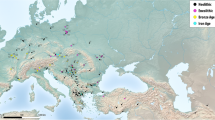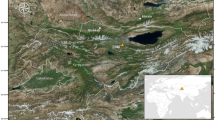Abstract
Little is known of the archaeobotany of the Bell Beaker period. The village of Cortaillod/Sur les Rochettes-est in Switzerland is one of the first settlements of this date discovered so far; and one of the few sites where systematic archaeobotanical research could be undertaken. The 114 features, mainly postholes, produced 5080 charred plant macrofossils. The composition of the cereal spectrum was dominated by hulled wheats and notably by Triticum spelta (spelt). Other important components were Triticum dicoccum (emmer) and T. monococcum (einkorn), and probably also Hordeum (barley). The abundance of spelt represents a fundamental change compared with the plant finds from earlier sites of the region. The origin of this cereal species is discussed in the light of recent results of cytogenetic and molecular research.




Similar content being viewed by others
References
Aeschimann, D., Heitz, C. (1996). Index synonymique de la Flore de Suisse. Documenta Floristicae Helvetiae, 1. Genève, Centre du Réseau Suisse de Floristique
Billard, C., Aubry, B., Blancquaert, G., Bourhis, J.-R., Habasque, G., Marinval, P., Pinel, C., Ropars, A. (1994). Poses - Le Vivier - Le Clos-Saint-Quentin (Eure): L’occupation de la plaine inondable au Néolithique et au début de l’âge du Bronze. Revue archéologique de l’Ouest, 11, 53–113
Blatter, R.H.E., Jacomet, S., Schlumbaum, A. (2002). Spelt-specific alleles in HMW glutenin genes from modern and historical European spelt (Triticum spelta L.). Theoretical and Applied Genetics, 104, 329–337
Blatter, R.H.E., Jacomet, S., Schlumbaum, A. (2004). About the origin of European spelt (Triticum spelta L.): allelic differentiation of the HMW Glutenin B1–1 and A1-2 subunit genes. Theoretical and Applied Genetics, 108, 360–367
Boardman, S., Jones, G. (1990). Experiments on the effects of charring on cereal plant components. Journal of Archaeological Science, 17, 1–11
Bouby, L. (1998). La torréfaction des glands. Archéologia hors-série, 9, 61
Brombacher, C. (1995). Wirtschaftliche Entwicklung aufgrund archäobotanischer Daten. In: Stöckli, W.E., Niffeler, U., Gross-Klee, E. (eds) SPM II: Neolithikum. Verlag Schweizerische Gesellschaft für Ur- und Frühgeschichte, Basel, pp 86–96
Buurman, J. (1990). Verkoolde eikeltjes uit de Ijzertijd [Charred acorns of the Iron Age]. Nieuwsblad Monumententzorg en Archeologie. Gemeentewerken Amersfoort, 22, 3–4
Buxó, R. (1997). Arqueología de las plantas. Barcelona, Crítica
Combe, A., Rieder, J. (2004). Plateau de Bevaix, 1. Pour une première approche archéologique : cadastres anciens et géoressources. Archéologie neuchâteloise, 30. Neuchâtel, Service et musée cantonal d’archéologie
de Hingh, A.E. (2000). Food production and food procurement in the Bronze Age and Early Iron Age (2000–500 BC). Archaeological Studies Leiden University, 7. Leiden, Faculty of Archaeology, Leiden University
Dvorák, J., Luo, M.-C. (2001). Evolution of free-threshing and hulled forms of Triticum aestivum: old problems and new tools. In: Caligari, P.D.S., Brandham, P.E. (eds) Wheat taxonomy: the legacy of John Percival. The Linnean, special issue, 3. Academic, New York, pp 127–136
Gyulai, F. (2003). Archaeobotanical remains and environment of Bell Beaker Csepel-Group. In: Czebreszuk, J., Szmyt, M. (eds) The northeast frontier of Bell Beakers. Prodeedings of the symposium held at the Adam Mickiewicz University, Poznan (Poland), May 26–29 2002. BAR International Series, 1155. Archaeopress, Oxford, pp 277–282
Hénon, P., Vérot-Bourrély, A. (1998). Habitats néolithiques, protohistoriques et occupations historiques du site de “Derrière-le-Château”, à Géovreissiat et Montréal-La Cluse - Ain - France. In: Frère-Sautot, M.-C. (ed) Paléométallurgie des cuivres. Actes du colloque de Bourg-en-Bresse et Beaune, 17–18 October 1997. Montagnac, Editions Monique Mergoil, pp 207–249
Hillman, G.C., Mason, S., de Moulins, D., Nesbitt, M. (1995). Identification of archaeological remains of wheat: the 1992 London workshop. Circaea, 12, 195–209
Hopf, M. (1981). Pflanzliche Reste aus Zambujal. In: Sangmeister, E., Schubart, H. (eds) Zambujal. Die Grabungen 1964 bis 1973. Madrider Beiträge, 5. Mainz, von Zabern, pp 315–340
Jaaska, V. (1978). NADP-dependent aromatic alcohol dehydrogenase in polyploid wheats and their relatives. On the origin and phylogeny of polyploid wheats. Theoretical and Applied Genetics, 53, 209–217
Jacomet, S., Rachoud-Schneider, A.-M., Zoller, H., Burga, C.A. (1998). Vegetationsentwicklung, Vegetationsveränderung durch menschlichen Einfluss, Ackerbau, Sammelwirtschaft. In: Hochuli, S., Niffeler, U., Rychner, V. (eds) SPM III: Bronzezeit. Basel, Verlag Schweizerische Gesellschaft für Ur- und Frühgeschichte, pp 141–170
Karg, S., Haas, J.N. (1996). Indizien für den Gebrauch von mitteleuropäischen Eicheln als prähistorische Nahrungsressource. Tübinger Monographien für Urgeschichte, 11, 429–435
Kerber, E.R., Rowland, G.G. (1974). Origin of the free threshing character in hexaploid wheat. Canadian Journal of Genetics and Cytology, 16, 145–154
Liu, Y.-G., Tsunewaki, K. (1991). Restriction fragment length polymorphism (RFLP) analysis in wheat. II. Linkage analysis of the RFLP sites in common wheat. Japanese Journal of Genetics, 66, 617–633
MacKey, J. (1966). Species relationship in Triticum. Hereditas, Supplement, 2, 237–276
Maier, U. (1996). Morphological studies of free-threshing wheat ears from a Neolithic site in southwest Germany, and the history of the naked wheats. Vegetation History and Archaeobotany, 5, 39–55
Maier, U. (1998). Der Nacktweizen aus den neolithischen Ufersiedlungen des nördlichen Alpenvorlandes und seine Bedeutung für unser Bild von der Neolithisierung Mitteleuropas. Archäologisches Korrespondenzblatt, 28, 205–218
Matthias, W., Schultze-Motel, J. (1969). Kulturpflanzenabdrücke an schnurkeramischen Gefässen aus Mitteldeutschland. Jahresschrift für mitteldeutsche Vorgeschichte, 53, 309–344
Mermod, O. (2000). Die endneolithische Seeufersiedlung Saint-Blaise/Bains des Dames NE: Botanische Untersuchungen zur Vegetation, Landwirtschaft und Ernährung in der Auvernier Cordé-Kultur (2640–2450 BC.). ETH Zürich, Doctoral thesis
Miller, T.E. (1992). A cautionary note on the use of morphological characters for recognising taxa in wheat (genus Triticum). In: Anderson, P.C. (ed) Préhistoire de l’agriculture. Monographie du CRA, 6. Paris, Editions du CNRS, pp 249–253
Nesbitt, M. (2001). Wheat evolution: integrating archaeological and biological evidence. In: Caligari, P.D. S., Brandham, P.E. (eds) Wheat taxonomy: the legacy of John Percival. The Linnean, special issue, 3. Academic, New York, pp 37–59
Nesbitt, M., Samuel, D. (1996). From stable crop to extinction? The archaeology and history of the hulled wheats. In: Padulosi, S., Hammer, K., Heller, J. (eds) Hulled wheats. Proceedings of the First International Workshop on Hulled Wheats, 21–22 July 1995, Castelvecchio Pascoli, Tuscany, Italy. Promoting the conservation and use of underutilized and neglected crops, 4. Rome, International Plant Genetic Resources Institute, pp 41–100
Ohtsuka, I. (1998). Origin of central European spelt wheat. In: Slinkard, A.E. (ed) 9th international wheat genetics symposium. University of Saskatchewan Extension Press, Saskatoon, pp 303–305
Pals, J.-P., Voorrips, A. (1979). Seeds, fruits and charcoals from two prehistoric sites in northern Italy. Archaeo-Physika, 8, 217–235
Rigert, E., Jacomet, S., Hosch, S., Hüster-Plogmann, H., Rentzel, P., Pümpin, C., Affolter, J. (in press). Eine Fundstelle der Glockenbecherzeit in Wetzikon-Kempten ZH, Tösstalstrasse 32–36. Jahrbuch der Schweizerischen Gesellschaft für Ur- und Frühgeschichte, 88
Robinson, D. (1992). Analyse af planterester fra Lodbjerg - en “sæter” boplads fra klokkebægerkultur i Vestthy [Analysis of plant remains from a Bell Beaker site in Vestthy]. Nationalmuseets Naturvidenskabelige Undersøgelser, 28, 1–7
Robinson, D.E. (2003). Neolithic and Bronze Age agriculture in southern Scandinavia - recent archaeobotanical evidence from Denmark. Environmental Archaeology, 8, 145–165
Schneider, M. (1990). Acorns as a staple food - different types and change of exploitation through time. Die Bodenkultur, 41, 81–88
Schultze-Motel, J., Gall, W. (1994). Archäologische Kulturpflanzenreste aus Thüringen. Weimarer Monographien zur Ur- und Frühgeschichte, 32. Stuttgart, Theiss, Stuttgart
Tempír, Z. (1985). Nálezy zbytku kulturních rostlin a plevelu v Holubicích [Finds of remains of cultivated plants and weeds from Holubice]. Archeologické Rozhledy, 37, 391–392
von Burg, A. (2002). Die Glockenbecherkultur auf dem Plateau von Bevaix. Archäologie der Schweiz, 25, 48–57
Zohary, D., Hopf, M. (2000). Domestication of plants in the old world. Oxford University Press, Oxford
Acknowledgements
I wish to thank B. Arnold and M. Egloff of the Musée et Service Cantonal d’Archéologie de Neuchâtel for funding archaeobotanical research in the A5 project. I am very grateful to A. von Burg for archaeological information about the site and to Kazi Aktheruzzaman, R. Aladé Kossi, I. Geith-Chauvière and M. Christen for their assistance in processing and analysing the plant remains. I gratefully acknowledge R. Blatter, L. Bouby, R. Giles, F. Gyulai, S. Hosch, S. Jacomet, M. Kühn, E. Marinova, D.E. Robinson, M. Rottoli, and A. Schlumbaum for information and discussions about the subject, S. Jacomet, M. Kohler-Schneider and an unknown referee for comments on an earlier version of the manuscript, and M. Collinge and J. Carrott for improving the English text
Author information
Authors and Affiliations
Corresponding author
Rights and permissions
About this article
Cite this article
Akeret, Ö. Plant remains from a Bell Beaker site in Switzerland, and the beginnings of Triticum spelta (spelt) cultivation in Europe. Veget Hist Archaeobot 14, 279–286 (2005). https://doi.org/10.1007/s00334-005-0071-1
Accepted:
Published:
Issue Date:
DOI: https://doi.org/10.1007/s00334-005-0071-1




